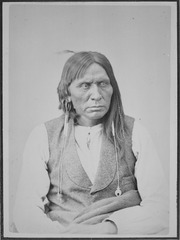Waco people
 Long Soldier, a Waco man, 1872 | |
| Total population | |
|---|---|
| fewer than 2,953[1] (2018) | |
| Regions with significant populations | |
| Oklahoma, historically Texas | |
| Languages | |
| English, formerly Wichita | |
| Religion | |
| Native American Church, Christianity, indigenous religion | |
| Related ethnic groups | |
| Caddo, Pawnee, other Wichita and Affiliated Tribes |
The Waco (also spelled Huaco[2] and Hueco[3]) of the Wichita people are a Southern Plains Native American tribe that inhabited northeastern Texas.[4] Today, they are enrolled members of the federally recognized Wichita and Affiliated Tribes, headquartered in Anadarko, Oklahoma.
History[edit]
The Waco were a division of the Wichita people, called Iscani or Yscani in the early European reports, kinsmen to the Tawakoni people. The present-day Waco, Texas, is located on the site of their principal village, that stood at least until 1820.[5] French explorer Jean-Baptiste Bénard de la Harpe travelled through the region in 1719, and the people he called the Honecha or Houecha could be the Waco.[6] They are most likely the Quainco on Guillaume de L'Isle's 1718 map, Carte de la Louisiane et du Cours du Mississipi.[7][8]
The Waco village on the Brazos River was flanked by two Tawakoni villages: El Quiscat and the Flechazos. In 1824, Stephen F. Austin wrote that the Waco village was 40 acres large, with 33 grass houses and about 100 men. They grew 200 acres of corn, in fields enclosed by brush fences. As late as 1829, the village was protected by defensive earthworks.[6] In 1837, the Texas Rangers planned to establish a fort at Waco village, but abandoned the idea after several weeks. In 1844, a trading post was established 8 miles south of the village.[9] The anthropologist Jean-Louis Berlandier recorded 60 Waco houses in 1830.[10]
The tribe had a second, smaller village located on the Guadalupe River.[10]
In 1835, 1846, and 1872, the tribe signed treaties with the United States and the Wichita. The 1872 treaty established a reservation for them in Indian Territory, to which they were removed. In 1902, under the Dawes Allotment Act, the reservation lands were broken into individual allotments, and the Wacos became citizens of the United States.[6] Today, they are part of the Wichita and Affiliated Tribes.
Culture[edit]
The tribe lived in beehive-shaped houses, with pole supports, typically covered with rushes, but sometimes buffalo hides. The houses stood 20 to 25 feet tall. Besides corn, Wacos also grew beans, melons, peach trees, and pumpkins.[9]
Waco descendants and other citizens of the Wichita and Affiliated Tribes are partnering with cultural organizations in Waco, Texas, educate the public about Waco history and create new opportunities for the city to work with Wichita people.[11]
Language[edit]
The Waco people spoke a dialect called Waco, which is a branch of Wichita (one of the Caddoan languages). The dialect is extinct.
Namesakes[edit]
The city of Waco, Texas, is named for the tribe,[12][9] as probably is Hueco Springs (Waco Springs) near New Braunfels, Texas.[10][13]
References[edit]
- ^ Gately, Paul (8 July 2018). "Native Americans chose Waco for water and abundance, like others". 10 KWTX. Retrieved 8 December 2018.
- ^ Straley, Wilson (1909). The Archaeological Bulletin. p. 132.
[...] the city of Waco, Texas, the former home of the Huaco (Waco) Indians.
- ^ Henry, Joseph; Baird, Spencer Fullerton (1856). Reports of explorations and surveys. A.O.P. Nicholson. p. 27.
the Huéco tribe [...] Hueco Indians
- ^ Sturtevant 6
- ^ "Waco Springs, Site of the Waco Indian Village - Waco ~ Marker Number: 5692". Texas Historic Sites Atlas. Texas Historical Commission. 1936.
- ^ a b c Waco Indian History. Access Genealogy. (retrieved 26 Oct 2010)
- ^ Ricky, Donald (1998). Encyclopedia of Texas Indians. North American Book Dist. p. 353. ISBN 978-0-403-09774-6.
- ^ de L'Isle's map.
- ^ a b c Waco Convention & Visitors Bureau, "Waco History." Archived 2015-01-06 at the Wayback Machine (retrieved 26 Oct 2010)
- ^ a b c Moore, R. Edward. "The Waco Indians or Hueco Indians." Texas Indians. (retrieved 26 Oct 2010)
- ^ Hoover, Carl (3 November 2023). "Wichitas hope Waco visit builds beneficial relationships". Waco Tribune-Herald. Retrieved 4 November 2023.
- ^ Mencken, H.L. (1948). American Language Supplement 2. Knopf Doubleday (1990 reprint). p. 1050. ISBN 978-0-307-81344-2.
Many other non-English place-names have been subjected to the same barbarization. [...] Waco in Texas was the Spanish Hueco.
- ^ Greene, Daniel P. (2010). "Waco Springs, TX". Handbook of Texas Online. Texas State Historical Association.
There are differing explanations for the name of the site: that it was named for the Indian tribe; that the name comes from Spanish hueco (empty) and was chosen because the springs occasionally run dry.
Further reading[edit]
- Sturtevant, William C., general editor and Raymond D. Fogelson, volume editor. Handbook of North American Indians: Southeast. Volume 14. Washington DC: Smithsonian Institution, 2004. ISBN 0-16-072300-0.
